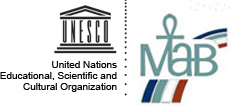Around 1,000 participants attending the 4th World Congress of Biosphere Reserves approved a new 10-year Action Plan for the Man and the Biosphere (MAB) Programme of the UN Educational, Scientific and Cultural Organization (UNESCO), aimed at enhancing synergies with the 2030 Agenda for Sustainable Development and the Paris Climate Agreement.
 19 March 2015: Around 1,000 participants attending the 4th World Congress of Biosphere Reserves approved a new 10-year Action Plan for the Man and the Biosphere (MAB) Programme of the UN Educational, Scientific and Cultural Organization (UNESCO), aimed at enhancing synergies with the 2030 Agenda for Sustainable Development and the Paris Agreement on climate change.
19 March 2015: Around 1,000 participants attending the 4th World Congress of Biosphere Reserves approved a new 10-year Action Plan for the Man and the Biosphere (MAB) Programme of the UN Educational, Scientific and Cultural Organization (UNESCO), aimed at enhancing synergies with the 2030 Agenda for Sustainable Development and the Paris Agreement on climate change.
Immediately following the Congress, which convened from 14-17 March 2016, in Lima, Peru, the MAB International Coordinating Committee designated 20 new sites and nine extensions to the World Network of Biosphere Reserves, bringing the total to 669 sites in 120 countries, including 16 transboundary sites.
The first Congress to take place outside of Europe, the 4th World Congress of Biosphere Reserves was organized by UNESCO in cooperation with Peru’s Ministry of the Environment (MINAM) and its National Service of Natural Areas Protected by the State (SERNANP). During numerous workshops and side events, participants showcased the role of biosphere reserves as “testing grounds” in the fight against climate change and for environmental education, sustainable tourism for economic development, and cooperation with local communities.
In the Lima Declaration, which was adopted at the close of the Congress, participants committed themselves to “identify and designate one biosphere reserve in each state that had not established one yet” and called for “a wider and more active role” for local communities in the management of the reserves and the establishment of new partnerships between science and policy, national and local governance, and public and private sector actors.
Welcoming the adoption of the Declaration and Action Plan, Flavia Schlegel, Assistant UNESCO Director-General for Natural Science, noted that Biosphere reserves provide the UN with “a unique model for the hands-on realization of sustainable development” that brings together all actors involved in the management of biosphere reserves, including states, local authorities, indigenous communities, youth and the private sector.
The newly designated biosphere reserves cover sites across Africa, Asia, Europe, and North and South America and represent diverse marine and terrestrial ecosystems critical to wildlife, biodiversity and genetic conservation. Many sites include major archaeological monuments and “cultural landscapes” with significant potential to contribute to sustainable livelihoods for indigenous groups and local populations through tourism and other economic activities.
UNESCO established the Man and Biosphere Programme in the early 1970s as an intergovernmental scientific endeavor to improve relations between people around the world and their natural environment. Biosphere reserves are intended as places for learning about sustainable development and reconciling the conservation of biodiversity with the sustainable use of natural resources. Each year, the International Coordinating Council of the Programme, which brings together elected representatives of 34 UNESCO member States, designates new reserves to the worldwide network. [UNESCO Press Release on Outcome of 4th World Congress] [UNESCO Press Release on Designation of New Biosphere Sites] [4th World Congress Website] [UNESCO Man and the Biosphere Programme Website] [IISD RS Story on Alignment of AfriMAB Programme to SDGs] [IISD RS Story on New Biosphere Reserves Designated in 2015]